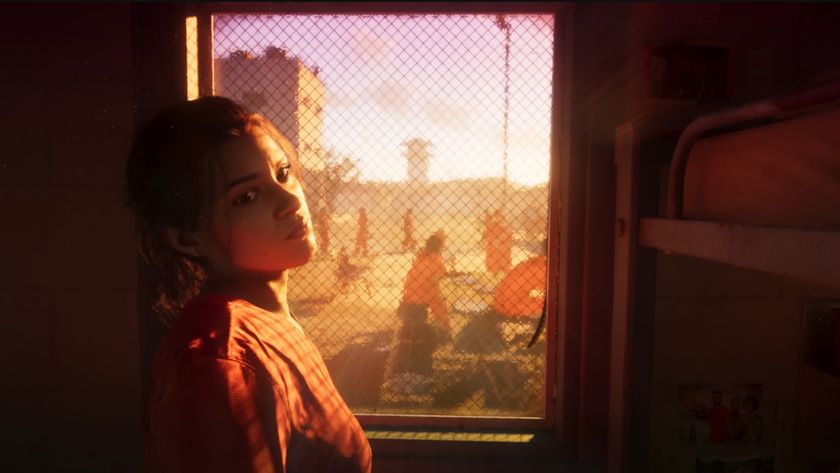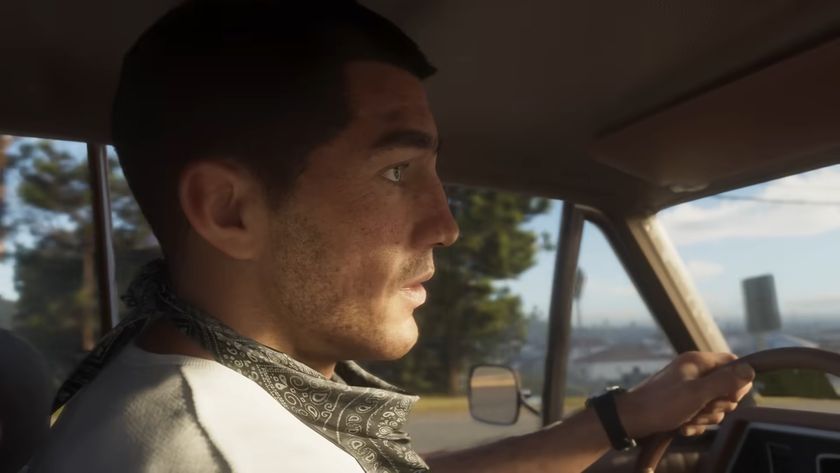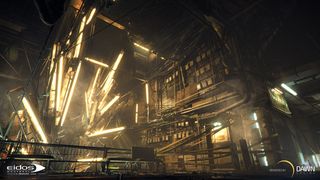
A New Dawn
This picture might look familiar. The various shades of yellow, the impractical but oh-so futuristic fluorescent bulb formation - it's Deus Ex all over. Of course, for a long time, we weren't technically supposed to know that.
Eidos Montreal released this in-engine image of Dawn well before they were ready to announce Mankind Divided, the first game to utilise their new-gen engine. You may detect a hint of vagueness about what game could possibly use such a thing. That's presumably because Director of Technology, Julien Bouvrais and Art Director, Martin Dubeau presumably had lawyers holding non-disclosure agreements origami-ed into the shapes of guns held up to their employment contracts while we talked to them.
What we did get was a tonne of deliciously nerdy detail on building a proprietary engine, how (or if) it could be applied to other Square Enix games and lots of uses of words we had to look up the meaning of. Enjoy!

OXM: The big question on everyone's lips ours, anyway is why 'Dawn Engine'? Is the name symbolic of anything in particular?
Eidos: The name Dawn is metaphorical, and represents the beginning/dawn of a new era for Eidos Montreal in terms of both ambitions and philosophy. It is also inherently linked to our vision for the future of the Deus Ex franchise.
OXM: It sounds like you taken a game-first approach to the engine creating a tool to enable a specific vision. Is this the usual approach when developing a new game engine?
Eidos: During our development of Human Revolution, we had to adapt our gameplay/environments according to what we were capable of creating within our existing engine. While we were very happy with the results, it helped us understand that, if we wanted to really push things to the next level, wed have to build an engine crafted specifically to our needs. We cant necessarily say if this is the typical approach within the industry, but it is almost always something that is considered when developing AAA titles.
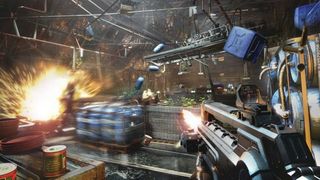
OXM: When you say it is an engine tailored to your needs, could you outline what those needs are?
Eidos: The Deus Ex franchise has a very unique art direction, where the ambition is to create an immersive and unparalleled game world. In turn, we wanted to make sure that this engine allowed us to push the limits of our creative vision.
That said, here is a brief list of some of the needs the engine is tailored towards:
A physically based material pipeline to achieve a realistic and tangible world;
A color grading tool to help enhance image quality in real time;
High polygon counts to improve the visual fidelity of environments, while also helping to better define the visual details of all the objects/characters within the world.
A volumetric lighting system that will allow for multiple light sources, increasing the depth and detail of each and every scene.
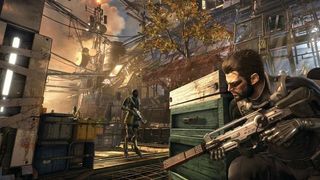
OXM: Does building a new engine to serve a specific need not run the risk of painting yourself into a corner? You've called it the cornerstone of the Deus Ex Universe, but could it equally be applied to a Final Fantasy, a Hitman or something even more 'out there'?
Eidos: We wouldnt go so far as to say that the Dawn Engine specifically serves the needs of the next Deus Ex game. However, it is certainly going to assist in making a new generation Deus Ex possible, particularly by addressing specific areas we felt needed improvement.
For a game like Deus Ex, we want to be able to accommodate our creative vision, and we dont want to limit ourselves to what a multi-purpose engine can do. Take the Unreal Engine for instance. This is a very good piece of technology, which enables development teams to quickly design and create the core content for a game. Its also fairly easy to learn, but it comes with a few limitations. If you can live with these, thats fine, but if you are trying to make a game that needs to go beyond those limits, you will be forced to either work within the limitations of the engine, or make changes to it. This can be a very time consuming, and can potentially create more problems than it solves. With Dawn, we can easily avoid these types of situations, putting less time solving technical problems, and allowing us to put more focus on creating an awesome experience for gamers.
It is very much possible, and is our hope, that it will be used to craft other experiences in the future. We are, however, very confident that it will greatly assist us in creating some of the things youve come to expect from the Deus Ex franchise.
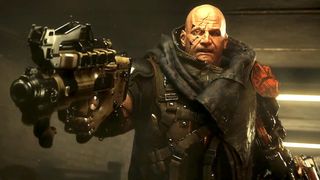
You worked using IO's Glacier engine as a base what are the strengths of that engine, and what areas did you hope to most improve/alter?
At its base, Glacier 2 is a very good engine. It provides the ability to implement game logic and design elements rapidly, along with some more complex elements (such as AI), without requiring any low level coding. It does this through what we call entities. An entity is a block of logic that performs an operation given a set of inputs. Assembling, piping and organizing those entities together actually creates behaviors. Those are then attached to characters or objects to create gameplay. This can become quite complex, but it is a very great tool to have within an engine.
That being said, in order to make the engine more efficient for a game like Deus Ex, we had to create some new tools, whilst also working to improve existing ones. Most of these are related to the way we tell the story, shape the characters and setup gameplay.
We also invested a lot in improving the graphics engine, opting to almost completely rewrite the original version in G2. This was done in order to insure that we were fully leveraging the power offered by the PC and new gen consoles. As a result, it is very easy to create both compelling and complex visual settings within the Dawn engine.

OXM: The released image is designed to show us what the Dawn Engine could do. Could you maybe pick out a few elements in that screen that demonstrate engine features you're particularly proud of?
Eidos:
1. We cant miss the most important feature here, and its everywhere in the framethat is the skill of the artists that made the creation of this scene possible.
2. The color grading tool allows us to alter and enhance the frames colors in order to reach levels of quality that match what you see in motion pictures.
3. Thanks to our new rendering system, materials are accurately portrayed throughout the world, no matter the lighting conditions.
4. The ability to saturate an environment with a staggering amount of objects, resulting in a more real and lived-in feel throughout all the areas in the game.
5. The subtle depth-of-field and chromatic aberration simulates a real camera lens.
6. The air density feature adds more depth into our scenes, helping the lighting to blend into empty spaces.
7. The unsharp mask post-processing gives us a crisper and less blurry image.

The official source for everything Xbox One, Xbox 360, and Xbox Series X. We're also a magazine, covering all things Xbox in the UK and the US. Originally established in 2001, the magazine was discontinued in April 2020.
Most Popular







